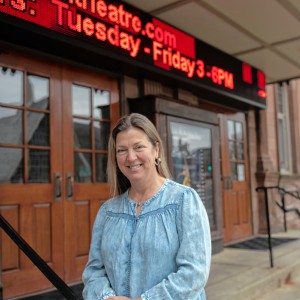Get Growing: Mass Aggie Seed Library at UMass Amherst makes free seeds accessible to all
| Published: 02-16-2023 8:35 PM |
It’s February. A few days ago, the temperature outside was an untoasty -10 degrees, weather that challenges the reaches of our imaginations to conjure images of newly planted vegetable seeds sprouting in our gardens. But it’s never too soon to start planning for the growing season ahead.
As we all know, it’s easy to run up a big tab when ordering seeds from seed catalogs, and each pricey packet contains far more seeds than we’ll plant in a year or two. Even if we limit our selections judiciously — say, only three kinds of tomatoes, a few bean and squash varieties and some zinnias for color — a dozen or so packets of seeds can run upwards of $50.
Fortunately, it’s not necessary to buy seeds to have a robust vegetable or flower garden. For frugal gardeners, or anyone interested in seed-saving, the Mass Aggie Seed Library at the University of Massachusetts Amherst is an invaluable resource. It offers free access to hundreds of varieties of organic, open-pollinated and heirloom vegetable and flower seeds on a self-serve basis.
The seed library was started in 2019 when an undergraduate biology student approached PaulinaBorrego, a UMass science librarian, with the idea of starting a seed library at UMass. Borrego was delighted by the suggestion. She had recently moved into the section of the library that serves the Environmental Conservation, Animal and Veterinary Science, and Food Science departments and she thought that the seed library would be a great outreach project for her to connect with those groups. “I wanted to pedal something new and different,” she said, “and I’m a gardener.”
She and the student met weekly to plan the library. Borrego visited several local seed libraries and was struck by how different they all were. “Some were really high tech, which required a lot of cataloging and organization. They decided to go low tech. “Light and breezy,” said Borrego.
“We wanted it to be accessible. UMass is a barrier in itself. People don’t know where to find things, where to park. We didn’t want to add any more difficulty.” The result of their planning efforts fully reflects that approach. “No library cards are needed,” said Borrego. “I’m always here to help out, but people can help themselves.”
She and the student met weekly to plan the library. Borrego visited several local seed libraries and was struck by how different they all were. “Some were really high tech, which required a lot of cataloging and organization. They decided to go low tech.
“Light and breezy,” said Borrego. “We wanted it to be accessible. UMass is a barrier in itself. People don’t know where to find things, where to park. We didn’t want to add any more difficulty.” The result of their planning efforts fully reflects that approach. “No library cards are needed,” said Borrego. “I’m always here to help out, but people can help themselves.”
Article continues after...
Yesterday's Most Read Articles
 ‘Home away from home’: North Amherst Library officially dedicated, as anonymous donor of $1.7M revealed
‘Home away from home’: North Amherst Library officially dedicated, as anonymous donor of $1.7M revealed
 Super defers Amherst middle school principal pick to successor; one finalist says decision is retaliation for lawsuit
Super defers Amherst middle school principal pick to successor; one finalist says decision is retaliation for lawsuit
 Granby Bow and Gun Club says stray bullets that hit homes in Belchertown did not come from its range
Granby Bow and Gun Club says stray bullets that hit homes in Belchertown did not come from its range
 Connecticut man gets 8 years in Hadley shooting
Connecticut man gets 8 years in Hadley shooting
 Design Review Board in Amherst backs 5-story apartment project connected to old Hastings building
Design Review Board in Amherst backs 5-story apartment project connected to old Hastings building
 Political newcomer defeats Shores Ness for Deerfield Selectboard seat
Political newcomer defeats Shores Ness for Deerfield Selectboard seat
As Borrego explains, she’s on her third career. She started as a chemist, then taught high-school chemistry for twenty years, and finally decided she’d like to become a science librarian. Borrego describes herself as a “doer.”
“My husband and I tore down our house and rebuilt it from the ground up with our own hands,” she said. “So I figured I could make a seed library.” She claimed a drab, empty space in the Science and Engineering Library that students don’t use because it has no electrical outlets for charging cellphones and laptops. She transformed the space into a cheerful, welcoming place, painting the walls bright green and decorating them with colorful pictures of old-fashioned seed packets and a large butterfly mural painted by students.
In addition to seeds, the library offers an impressive collection of books about gardening and seed saving. Tools for seed-planting and seed-saving will soon be available for loan. A community library card is needed to check out books and tools. There’s also an assortment of magazines and seed catalogs for visitors to browse and a bulletin board where people can post questions.
Without a nickel of funding, Borrego furnished the seed library “on the cheap,” scavenging an old wooden card catalog and an atlas table from the building’s basement. For $25 on Craigslist, Borrego bought a big glass exhibition case that had been salvaged from Steiger’s Department Store in Greenfield, as well as shelving for seed-saving equipment. Borrego said she prefers taking the frugal approach. “When you spend a lot of money on something,” she said, “you become married to that idea, stuck with it. This way, we can be responsive to how things go. We can be flexible.”
The seed borrowing process is simple. The drawers of the card catalog are labeled with the names of particular vegetables, both common and scientific. “I don’t want to put people off by using only the scientific name,” said Borrego. Each drawer contains numerous varieties of the vegetables for people to choose from. The beet drawer, for example, offers gold beets, red beets, striped beets and many others. People find the seeds they want, scoop out the amount they think they’ll use, and put them into a small envelope. Then they reseal the seed packet with tape and return it to the drawer. The wide top of the atlas stand provides an ample workspace for seed seekers.
There is a printed instruction sheet for newcomers and a check-out log for people to list the seeds they take. This helps Borrego keep track of what seeds need to be restocked. Each packet is marked with a different colored dot to indicate the year the seed was produced. Some seeds have longer shelf-lives than others. When the seeds are officially expired, they are placed in the “Who Knows?” drawer. Borrego explains that the older seeds can still be planted but they have lower germination rates.
The library’s seeds come from several sources. All are organic and open-pollinated (this is a subject I’ll tackle in another column!). Many are donated by seed companies including Baker Creek, High Mowing Seeds, Hudson Valley Seed and Seed Savers’ Exchange. Some are donated by members of the community. Others are saved seed that gardeners have collected. With funding from the UMass Amherst Sustainability, Innovation and Engagement Fund, Borrego is now able to buy seeds to supplement the collection. For the most popular varieties, she buys in quantity and then repackages them into smaller “to go” packs.
Borrego is always ready to go the extra mile. After the COVID-19 pandemic hit, she began to mail seeds to people who requested them. When that became too laborious, she created a seed mobile, loading her car with a portable catalog of seed packets and parking at various public places where people could come by appointment to take seeds.
She sees to it that everything in the library is aesthetically pleasing. Each “to go” pack is labeled with a copy of the original seed packet. The tiny envelopes that seed seekers use are individually stamped with the seed library’s distinctive seal. Borrego always has a jigsaw puzzle out for visitors to work on. “The kids love these,” she said, referring to the students, whom she clearly adores. “They live in their heads all the time. It’s so important for them to get out of their heads and use their hands for a while.”
Every spring Borrego mounts a special exhibition. This year she’s making colorful posters showing how seed is collected from ten different plants, part of the library’s mission to teach people how to harvest their own seeds for sharing and replanting. In the fall Borrego holds a series of “seed frenzy” workshops. Everyone who successfully completes the workshop becomes a Mass Aggie Seed Library Ambassador who is encouraged to help out in the seed library and to undertake projects on their own. Borrego has a core group of five or six volunteers who come every week or so to sort seeds, restock drawers, stamp envelopes and take care of other maintenance tasks.
Borrego is excited to be getting the word out about the seed library. As more people start growing their own vegetables for both health and budget reasons, seed libraries are becoming a popular way to acquire seeds. “If someone insists on having one particular variety of something, they’re probably better off buying from a catalog,” she said. “But if they’re not so picky, the seed library is the way to go.”
]]>

 A DIY approach to flying: Local pilots build and help build their own aircraft
A DIY approach to flying: Local pilots build and help build their own aircraft You’re up next: Western Mass open mic scene heats up post-pandemic
You’re up next: Western Mass open mic scene heats up post-pandemic One upon a story slam: This year’s Valley Voices winners head to a final competition
One upon a story slam: This year’s Valley Voices winners head to a final competition Preserving a key part of Emily Dickinson’s legacy: Historic Evergreens house reopens at the Emily Dickinson Museum
Preserving a key part of Emily Dickinson’s legacy: Historic Evergreens house reopens at the Emily Dickinson Museum